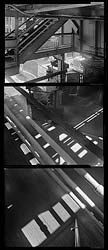
And so it is standing before Accra Shepp's recent photographs.
Eight, multi-paneled photographs comprise the aptly named exhibition "In the Loop," which opened October 7,
 |
There's a great scene from the 1993 hit movie, The Fugitive , in which Harrison Ford, playing a wanted man, reveals his location when he makes a phone call from beneath the Chicago El. We, along with the agents pursuing Ford's character, hear "Next stop Merchandise Mart" amid the usual urban cacophony and then there's that distinct deafening rumble of trains overhead. It is immediately decided that he could be only in Chicago, only in the loop.
And so it is standing before Accra Shepp's recent photographs. Eight, multi-paneled photographs comprise the aptly named exhibition "In the Loop," which opened October 7, |
2004, at the City Gallery in Chicago's landmark Water Tower. Here, a vision of Chicago's loop and the El that encircles it winds across the walls. We float above crosswalks, tip back to take in the top of a skyscraper, and lose ourselves in the labyrinth of vistas of glass, wood, and metal that are only possible from platforms suspended twenty-some feet in the air. Shepp strings together individual photographic frames taken with his 4 x 5 camera like so many compatible letters merging to form a complete word. Whether three or seven frames long (the longest picture spans 10 feet), the effect is a vision of Chicago methodically sounded out. This overall resonance of the pictures rests on the individual panels, which are both delineated by tell-tale negative edges and subsumed to the pronunciation of the cluster. In my favorite photograph, three panels, each approximately 18 by 28 inches, rise before us. Beginning at the bottom of Beneath Randolph (2004), we hover above a graphic criss-cross of light and shadow on the street below and then our eye climbs across and out from this spot to a network of stairs and platforms in the distance. For all the flow of this sequence, it seems entirely natural, a scene that might be glimpsed on the ascent to the El. But Shepp is keenly attuned to the tension between such seemingly natural visions and the requisite mechanics that make it possible. His subtle shifts in camera perspective are most discernible at the black edges of each photographic frame that make up the larger image, where a railing seems to bend away from its support or a lamppost tips precariously forward. These slight disconnects endow each image with slight, but effectual and unfailing reminders of what Shepp has called "our tendency to conflate human and camera vision." In these photographs, then, Shepp gives expression to a quintessential Chicago subject through the optical processes essential to photography. Literally arresting, yet at the same time unfurling, Shepp's is a vision of the city that can be seen only in Chicago, only in the loop, and only in photographs.
|